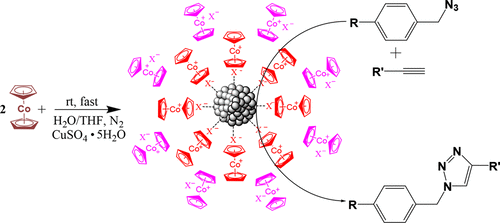当前位置:
X-MOL 学术
›
ACS Catal.
›
论文详情
Our official English website, www.x-mol.net, welcomes your
feedback! (Note: you will need to create a separate account there.)
Cobaltocene Reduction of Cu and Ag Salts and Catalytic Behavior of the Nanoparticles Formed
ACS Catalysis ( IF 11.3 ) Pub Date : 2018-07-24 00:00:00 , DOI: 10.1021/acscatal.8b02338 Fangyu Fu 1 , Roberto Ciganda 1, 2 , Qi Wang 1 , Alexis Tabey 1 , Changlong Wang 1 , Ane Escobar 3 , Angel M. Martinez-Villacorta 3 , Ricardo Hernández 2 , Sergio Moya 3 , Eric Fouquet 1 , Jaime Ruiz 1 , Didier Astruc 1
ACS Catalysis ( IF 11.3 ) Pub Date : 2018-07-24 00:00:00 , DOI: 10.1021/acscatal.8b02338 Fangyu Fu 1 , Roberto Ciganda 1, 2 , Qi Wang 1 , Alexis Tabey 1 , Changlong Wang 1 , Ane Escobar 3 , Angel M. Martinez-Villacorta 3 , Ricardo Hernández 2 , Sergio Moya 3 , Eric Fouquet 1 , Jaime Ruiz 1 , Didier Astruc 1
Affiliation

|
The modes of generation of nanoparticles (NPs) are of great interest for multiple applications in catalysis, optics, sensing, and nanomedicine. Here, fast reduction of CuSO4·5H2O and Ag salts by commercial cobaltocene yields small, stable, water-soluble Cu and Ag NPs with a narrow size distribution without any other ligand or support. The variation of the Ag salt counteranion (NO3–, F–, BF4–) strongly influences both the plasmonic absorption of the AgNPs synthesized in this way and the high apparent rate constant of the AgNP-catalyzed reduction of 4-nitrophenol by NaBH4, showing that the precursor counteranion binds to the AgNP surface. The CuNPs synthesized from CuSO4 and cobaltocene are a recyclable catalyst for the Cu-catalyzed alkyne–azide cycloaddition reaction in water extended to various azides and alkynes, including functionalization of compounds of biomedical interest. Both CuNP and AgNP catalytic activities are also very promising signs for further extension to a variety of other truly efficient metal-NP-catalyzed reactions.
中文翻译:

钴和铜盐的钴茂金属还原及其形成的纳米颗粒的催化行为
纳米粒子(NPs)的生成方式对于催化,光学,传感和纳米医学中的多种应用非常感兴趣。在此,通过商业钴将快速还原CuSO 4 ·5H 2 O和Ag盐得到的是小,稳定,水溶性的Cu和Ag NP,具有窄的尺寸分布,而没有任何其他配体或载体。银盐抗衡阴离子的变化(NO 3 -,F -,BF 4 - )强烈地影响以这种方式合成的的AgNPs和加入NaBH的AgNP催化的还原4-硝基苯酚的高表观速率常数的两个等离激元吸收4,表明前体抗衡阴离子与AgNP表面结合。由CuSO 4和钴并茂合成的CuNP是可循环的催化剂,用于水中Cu催化的炔-叠氮化物环加成反应,扩展至各种叠氮化物和炔烃,包括对生物医学感兴趣的化合物进行功能化。CuNP和AgNP的催化活性也是非常有希望的迹象,它们可以进一步扩展到各种其他真正有效的金属NP催化反应中。
更新日期:2018-07-24
中文翻译:

钴和铜盐的钴茂金属还原及其形成的纳米颗粒的催化行为
纳米粒子(NPs)的生成方式对于催化,光学,传感和纳米医学中的多种应用非常感兴趣。在此,通过商业钴将快速还原CuSO 4 ·5H 2 O和Ag盐得到的是小,稳定,水溶性的Cu和Ag NP,具有窄的尺寸分布,而没有任何其他配体或载体。银盐抗衡阴离子的变化(NO 3 -,F -,BF 4 - )强烈地影响以这种方式合成的的AgNPs和加入NaBH的AgNP催化的还原4-硝基苯酚的高表观速率常数的两个等离激元吸收4,表明前体抗衡阴离子与AgNP表面结合。由CuSO 4和钴并茂合成的CuNP是可循环的催化剂,用于水中Cu催化的炔-叠氮化物环加成反应,扩展至各种叠氮化物和炔烃,包括对生物医学感兴趣的化合物进行功能化。CuNP和AgNP的催化活性也是非常有希望的迹象,它们可以进一步扩展到各种其他真正有效的金属NP催化反应中。




















































 京公网安备 11010802027423号
京公网安备 11010802027423号